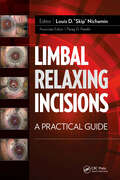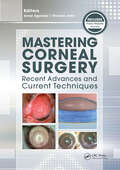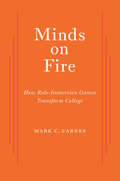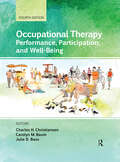- Table View
- List View
Light - The Physics of the Photon (Series in Optics and Optoelectronics)
by Ole KellerFrom the early wave-particle arguments to the mathematical theory of electromagnetism to Einstein's work on the quantization of light, different descriptions of what constitutes light have existed for over 300 years. Light - The Physics of the Photon examines the photon phenomenon from several perspectives. It demonstrates the importance of studyin
Limbal Relaxing Incisions: A Practical Guide
by Louis NichaminFor both surgeon and patient alike, the success of modern implant surgery is increasingly judged by the refractive and astigmatic outcome. In spite of this, there has not yet been a practical book that addresses the process of performing limbal relaxing incisions (LRIs). Dr. Louis D. “Skip” Nichamin and his contributors aim to fill this void with Limbal Relaxing Incisions: A Practical Guide.Limbal Relaxing Incisions serves as a guide for novice refractive implant surgeons looking to incorporate incisional astigmatism surgery into their repertoire. It also contains practical pearls that the more experienced practitioner can use to refine astigmatic refractive outcomes following lens-based surgery.Limbal Relaxing Incisions covers a wide range of information from the history, background, and future of astigmatism management, to important subjects such as measuring cylinder and strategic planning for the surgical correction of astigmatism. Dr. Nichamin and his contributors detail their personal approaches to the use of LRIs, each presenting a slightly different technique and providing simple clinical pearls for both the novice and experienced practitioner. In addition, the book offers a discussion on astigmatic enhancement surgery, potential complications, and insight into the emerging field of Femto-Second Laser technology to further refine and automate astigmatism correction.Residents in ophthalmology, comprehensive ophthalmologists, refractive cataract surgeons, and keratorefractive surgeons taking up lens-based refractive surgery will appreciate the “this is how I do it” approach in Limbal Relaxing Incisions: A Practical Guide, as well as the emphasis on clinical pearls, written by some of the most experienced refractive cataract surgeons in the field.
Limbal Relaxing Incisions: A Practical Guide
by Louis NichaminFor both surgeon and patient alike, the success of modern implant surgery is increasingly judged by the refractive and astigmatic outcome. In spite of this, there has not yet been a practical book that addresses the process of performing limbal relaxing incisions (LRIs). Dr. Louis D. “Skip” Nichamin and his contributors aim to fill this void with Limbal Relaxing Incisions: A Practical Guide.Limbal Relaxing Incisions serves as a guide for novice refractive implant surgeons looking to incorporate incisional astigmatism surgery into their repertoire. It also contains practical pearls that the more experienced practitioner can use to refine astigmatic refractive outcomes following lens-based surgery.Limbal Relaxing Incisions covers a wide range of information from the history, background, and future of astigmatism management, to important subjects such as measuring cylinder and strategic planning for the surgical correction of astigmatism. Dr. Nichamin and his contributors detail their personal approaches to the use of LRIs, each presenting a slightly different technique and providing simple clinical pearls for both the novice and experienced practitioner. In addition, the book offers a discussion on astigmatic enhancement surgery, potential complications, and insight into the emerging field of Femto-Second Laser technology to further refine and automate astigmatism correction.Residents in ophthalmology, comprehensive ophthalmologists, refractive cataract surgeons, and keratorefractive surgeons taking up lens-based refractive surgery will appreciate the “this is how I do it” approach in Limbal Relaxing Incisions: A Practical Guide, as well as the emphasis on clinical pearls, written by some of the most experienced refractive cataract surgeons in the field.
Listening to Scent: An Olfactory Journey with Aromatic Plants and Their Extracts
by Jennifer Peace Peace RhindThis imaginative book offers aromatherapy students and practitioners, as well as anyone interested in developing their olfactory palate, a unique and enjoyable way of acquiring and developing essential skills, such as olfactory vocabulary, awareness and discrimination. It also includes scent profiles for expanded practice.
Love and Mayhem: One Big Family's Uplifting Story of Fostering and Adoption
by John DeGarmoLove and Mayhem gives an insight into the inner-workings of a large family with fostered, adopted and birth children. John Degarmo, describes the highs and lows and complete chaos of his family life with warmth and sincerity.
Making Individual Service Funds Work for People with Dementia Living in Care Homes: How it Works in Practice
by Helen Sanderson Gill BaileyThrough clear practical examples, this book demonstrates how Individual Service Funds can dramatically improve the quality of life of people with dementia living in care homes, showing what works and what doesn't, how to deal with difficulties and setbacks and describing the person-centred planning tools needed to implement the approach.
Management of Retinal Vein Occlusion: Current Concepts
by Seenu HariprasadManagement of retinal venous occlusions (RVO) has changed dramatically in recent years. With an increase in medical information, technological advances, and clinical trials, ophthalmologists need a concise, updated reference. Management of Retinal Vein Occlusion: Current Concepts fills this current need in the market.In Management of Retinal Vein Occlusion, Dr. Seenu Hariprasad is joined by multiple section editors to provide this easy-to-read and nicely formatted resource, which is divided into organized sections:• Background: The epidemiology, risk factors, and classification of RVO• History: Seven large clinical trials involving RVO and the pros and cons of earlier treatment modalities• Anti-VEGF Therapies: The rationale and outcomes of large clinical trials• Corticosteroid Therapies: The rational and outcomes of various steroid treatment modalities• Imaging: Case presentations and emerging technology that highlights the relationship between peripheral ischemia and macular edema• Difficult cases: Combination therapies, management of recalcitrant cases, and surgical approaches for cases that do not respond to standard management• Future of RVO: A summary overview of the subject and future directionsWith an unparalleled list of contributors that are leaders in the retina field, Management of Retinal Vein Occlusion goes beyond the conclusions of clinical trials and delves deeper into practical recommendations for patient management in daily practice.With abundant illustrations, fundus photographs, concise tables, and summary boxes that enhance the written text, Management of Retinal Vein Occlusion: Current Concepts is a valuable resource.
Management of Retinal Vein Occlusion: Current Concepts
by Seenu HariprasadManagement of retinal venous occlusions (RVO) has changed dramatically in recent years. With an increase in medical information, technological advances, and clinical trials, ophthalmologists need a concise, updated reference. Management of Retinal Vein Occlusion: Current Concepts fills this current need in the market.In Management of Retinal Vein Occlusion, Dr. Seenu Hariprasad is joined by multiple section editors to provide this easy-to-read and nicely formatted resource, which is divided into organized sections:• Background: The epidemiology, risk factors, and classification of RVO• History: Seven large clinical trials involving RVO and the pros and cons of earlier treatment modalities• Anti-VEGF Therapies: The rationale and outcomes of large clinical trials• Corticosteroid Therapies: The rational and outcomes of various steroid treatment modalities• Imaging: Case presentations and emerging technology that highlights the relationship between peripheral ischemia and macular edema• Difficult cases: Combination therapies, management of recalcitrant cases, and surgical approaches for cases that do not respond to standard management• Future of RVO: A summary overview of the subject and future directionsWith an unparalleled list of contributors that are leaders in the retina field, Management of Retinal Vein Occlusion goes beyond the conclusions of clinical trials and delves deeper into practical recommendations for patient management in daily practice.With abundant illustrations, fundus photographs, concise tables, and summary boxes that enhance the written text, Management of Retinal Vein Occlusion: Current Concepts is a valuable resource.
Mastering Corneal Surgery: Recent Advances and Current Techniques
by Thomas John Amar AgarwalMastering Corneal Surgery: Recent Advances and Current Techniques comprehensively covers all the recent advances in the existing techniques for common and rare corneal conditions, as well as presents the potential intraoperative circumstances the surgeon can face with their patients.Mastering Corneal Surgery: Recent Advances and Current Techniques by Drs. Amar Agarwal and Thomas John, along with more than 50 contributors, cover the most recent innovations in corneal surgery, including corneal procedures in combination with IOL implantation in eyes with deficient capsules, and combining endothelial keratoplasty with IOL repositioning.Bonus!Extensive high-quality video demonstrations of the techniques discussed inside Mastering Corneal Surgery: Recent Advances and Current Techniques enhances the written text, creating a superior companion website resource. The 28 videos, combined with the written text, clinical photographs and pictures, furthers the learning process more than learning from text or video alone.Mastering Corneal Surgery: Recent Advances and Current Techniques covers all the recent advances in the existing techniques for common and rare corneal conditions and presents the potential intraoperative circumstances the surgeon can encounter with their patients. The general ophthalmologist and cornea specialist will welcome the novel surgical methods and their differences from the existing techniques highlighted inside this cutting-edge resource.
Mastering Corneal Surgery: Recent Advances and Current Techniques
by Thomas John Amar AgarwalMastering Corneal Surgery: Recent Advances and Current Techniques comprehensively covers all the recent advances in the existing techniques for common and rare corneal conditions, as well as presents the potential intraoperative circumstances the surgeon can face with their patients.Mastering Corneal Surgery: Recent Advances and Current Techniques by Drs. Amar Agarwal and Thomas John, along with more than 50 contributors, cover the most recent innovations in corneal surgery, including corneal procedures in combination with IOL implantation in eyes with deficient capsules, and combining endothelial keratoplasty with IOL repositioning.Bonus!Extensive high-quality video demonstrations of the techniques discussed inside Mastering Corneal Surgery: Recent Advances and Current Techniques enhances the written text, creating a superior companion website resource. The 28 videos, combined with the written text, clinical photographs and pictures, furthers the learning process more than learning from text or video alone.Mastering Corneal Surgery: Recent Advances and Current Techniques covers all the recent advances in the existing techniques for common and rare corneal conditions and presents the potential intraoperative circumstances the surgeon can encounter with their patients. The general ophthalmologist and cornea specialist will welcome the novel surgical methods and their differences from the existing techniques highlighted inside this cutting-edge resource.
Mastering Whole Family Assessment in Social Work: Balancing the Needs of Children, Adults and Their Families (Mastering Social Work Skills)
by Fiona MainstoneHow do you balance the needs of children, adults and their families when carrying out social work assessments? With tools and frameworks that make sense of the interface between adult problems and children's safety, this guide will help social workers generate high quality assessments that consider the well-being of both adults and children.
The Meditation Book of Light and Colour
by Pauline WillsMeditating with colour can be a powerful way to improve health and well-being. This handbook provides a full spectrum of easy-to-use colour breathing and visualisation exercises. Anyone can practice these simple meditations, and they are ideal for colour therapists, yoga instructors and CAM practitioners to use as guided meditations with clients.
MI29: Mouseweb International to the Rescue! (PDF)
by Sarah TozerThis is the story of Mouseweb International Department 29 (MI29), a worldwide network of mice monitoring human life and lending a paw to those in need. Agent Windsor Smith and his family are on a mission to help 13-year-old Lily Jane Watson. Can they successfully come to her rescue, or will they be defeated by a crafty gang of rats?
Mindfulness-Based Interventions for Older Adults: Evidence for Practice
by Carla MartinsThe first research-based book on the efficacy of Mindfulness Based Stress Reduction for older adults, presenting academics, students and professionals with robust new evidence to support MBSR's positive impact on older people's wellbeing and valuable guidance on how to tailor MBSR programmes to meet the particular needs of this group.
Minds on Fire: How Role-Immersion Games Transform College
by Mark C. CarnesA Choice Outstanding Academic Title of the YearIn Minds on Fire, Mark C. Carnes shows how role-immersion games channel students’ competitive (and sometimes mischievous) impulses into transformative learning experiences. His discussion is based on interviews with scores of students and faculty who have used a pedagogy called Reacting to the Past, which features month-long games set during the French Revolution, Galileo’s trial, the partition of India, and dozens of other epochal moments in disciplines ranging from art history to the sciences. These games have spread to over three hundred campuses around the world, where many of their benefits defy expectations.“[Minds on Fire is] Carnes’s beautifully written apologia for this fascinating and powerful approach to teaching and learning in higher education. If we are willing to open our minds and explore student-centered approaches like Reacting [to the Past], we might just find that the spark of student engagement we have been searching for in higher education’s mythical past can catch fire in the classrooms of the present.”—James M. Lang, Chronicle of Higher Education“This book is a highly engaging and inspirational study of a ‘new’ technique that just might change the way educators bring students to learning in the 21st century.”—D. D. Bouchard, Choice
The Moving Researcher: Laban/Bartenieff Movement Analysis in Performing Arts Education and Creative Arts Therapies
by Ciane FernandesThe Moving Researcher offers a complete approach to Laban/Bartenieff Movement Analysis, detailing the original method, exploring recent developments and examining its applications. With contributions from internationally renowned professionals at key institutions, this book covers all concepts taught as part of the Certificate of Movement Analysis.
The Music in Music Therapy: Psychodynamic Music Therapy in Europe: Clinical, Theoretical and Research Approaches
by Rachel Darnley-Smith Janet Corry Jaakko Erkkilä Rudi Vermote Jenny Wigram Teresa Leite Esa Ala-Ruona Karin Schumacher Monika Noecker-Ribaupierre Lieselotte Ronse Dorothee Storz Laurien Hakvoort Rita Maes Adriano Primadei Cathy Warner Niels Hannibal Jan Van Van Camp Elvira Martín Martín Martín Patxi Del Del Campo San VicenteThis text comprises of a wide range of thinking from across Europe, stressing how essential the musician is within the identity of a music therapist. With examples and clinical case material from across Europe, the editors provide insight into the aspects of the therapeutic process which are enabled by music.
Navigating the Medical Maze with a Child with Autism Spectrum Disorder: A Practical Guide for Parents
by Lisa Ford Julie O'Brien Jennifer Bain Mark D. Robinson Harumi Jyonouchi Jeffrey Kornitzer Caroline Hayes-Rosen Devorah Segal Tishi Shah Thomas Ballesteros Barbie Zimmerman-Bier Susan Brill Evan Spivack Susan Connors Iona Monterio Gary McAbeeThis practical guide contains everything parents of a child with autism need to know in order to get the best medical care for their child and to play an active and effective role in that care. It contains accessible descriptions and explanations of autism and related conditions, diagnostic tests, conventional and complementary therapies, and more.
Neuroscience for Counsellors: Practical Applications for Counsellors, Therapists and Mental Health Practitioners
by Rachal Zara WilsonThis book explains neuroscience discoveries in accessible, plain English and provides guidance on how to apply this knowledge to counselling practice in order to enhance understanding of clients' needs.
Occupational Therapy: Performance, Participation, and Well-Being
by Charles H. Christiansen Julie Bass Carolyn M. BaumOccupational Therapy: Performance, Participation, and Well-Being, Fourth Edition, is a comprehensive occupational therapy text that introduces students to core knowledge in the profession and the foundations of practice—the occupations, person factors, and environment factors that support performance, participation, and well-being. Editors, Drs. Charles H. Christiansen, Carolyn M. Baum, and Julie D. Bass, are joined by more than 40 international scholars who bring students, faculty, and practitioners the evidence that supports occupational therapy practice. The PEOP Model 4th Edition is featured as an exemplar of a person-environment-occupation model and provides a valuable roadmap for understanding key concepts and developing strong clinical reasoning skills in the occupational therapy process. Features: Examines the theories, models, frameworks, and classifications that support contemporary knowledge of person, environment, and occupational factors. Presents detailed chapters on the occupations of children and youth, adults, older adults, organizations, and populations Provides extensive coverage of the person factors (psychological, cognition, sensory, motor, physiological, spirituality) and environment factors (culture, social, physical, policy, technology) that support occupational performance Includes exceptional content on the essentials of professional practice - therapeutic use of self, evidence-based practice, professionalism, lifelong development, ethics, business fundamentals, and critical concepts Builds clear links with the AOTA’s Occupational Therapy Practice Framework, Third Edition; International Classification of Functioning, Disability and Health, and accreditation standards for entry-level occupational therapy programs. Introduces emerging practice areas of self-management, community-based practice, technology, and teaching/learning and opportunities to work with organizations and populations Incorporates international and global perspectives on core knowledge and occupational therapy practice. Documents assessments, interventions, resources, and evidence in user-friendly tables Uses simple and complex cases to illustrate key concepts and ideas. New and Updated Sections in the Fourth Edition: Individual chapters on each person factor and environmental factor and occupations across the lifespan Expanded coverage of approaches for organizations and populations and entry-level professional skills Consistent framework of tables and language across chapters and sections. Included with the text are online supplemental materials for faculty use in the classroom including PowerPoint presentations.
Occupational Therapy: Performance, Participation, and Well-Being
by Charles H. Christiansen Julie Bass Carolyn M. BaumOccupational Therapy: Performance, Participation, and Well-Being, Fourth Edition, is a comprehensive occupational therapy text that introduces students to core knowledge in the profession and the foundations of practice—the occupations, person factors, and environment factors that support performance, participation, and well-being. Editors, Drs. Charles H. Christiansen, Carolyn M. Baum, and Julie D. Bass, are joined by more than 40 international scholars who bring students, faculty, and practitioners the evidence that supports occupational therapy practice. The PEOP Model 4th Edition is featured as an exemplar of a person-environment-occupation model and provides a valuable roadmap for understanding key concepts and developing strong clinical reasoning skills in the occupational therapy process. Features: Examines the theories, models, frameworks, and classifications that support contemporary knowledge of person, environment, and occupational factors. Presents detailed chapters on the occupations of children and youth, adults, older adults, organizations, and populations Provides extensive coverage of the person factors (psychological, cognition, sensory, motor, physiological, spirituality) and environment factors (culture, social, physical, policy, technology) that support occupational performance Includes exceptional content on the essentials of professional practice - therapeutic use of self, evidence-based practice, professionalism, lifelong development, ethics, business fundamentals, and critical concepts Builds clear links with the AOTA’s Occupational Therapy Practice Framework, Third Edition; International Classification of Functioning, Disability and Health, and accreditation standards for entry-level occupational therapy programs. Introduces emerging practice areas of self-management, community-based practice, technology, and teaching/learning and opportunities to work with organizations and populations Incorporates international and global perspectives on core knowledge and occupational therapy practice. Documents assessments, interventions, resources, and evidence in user-friendly tables Uses simple and complex cases to illustrate key concepts and ideas. New and Updated Sections in the Fourth Edition: Individual chapters on each person factor and environmental factor and occupations across the lifespan Expanded coverage of approaches for organizations and populations and entry-level professional skills Consistent framework of tables and language across chapters and sections. Included with the text are online supplemental materials for faculty use in the classroom including PowerPoint presentations.
Ophthalmic Microsurgery: Principles, Techniques, and Applications
by Sumit Garg Roger SteinertExcellent microsurgery derives not from natural dexterity alone or from pure book knowledge, but from these features combined with an appreciation of the instrumentation, physical forces, and tissue reactions that create the environment of microsurgery. Ophthalmic Microsurgery: Principles, Techniques, and Applications conveys both the art and science of microsurgery from an ophthalmic perspective.This unique resource begins with the principles and techniques of microsurgery, which can be applied to all types of surgeries and includes detailed laboratory exercises to teach the key concepts. The second section of Ophthalmic Microsurgery addresses the specific applications. While not an encyclopedia of all surgical interventions, Drs. Sumit “Sam” Garg and Roger Steinert, along with their contributors, provide an overview of key surgical competencies that are relevant to the various ophthalmic subspecialties.Ophthalmic Microsurgery is set apart from other similar resources by having a comprehensive and concise focus on translating surgical principles into reality through simple and inexpensive exercises.Grounded in practicality and requiring only basic materials, Ophthalmic Microsurgery: Principles, Techniques, and Applications covers the theory and basics of microsurgery needed during the ophthalmic surgical training of residents and fellows and serves as an excellent manual for the more experienced ophthalmologists looking to refine their technique in microsurgery.
Ophthalmic Microsurgery: Principles, Techniques, and Applications
by Sumit Garg Roger SteinertExcellent microsurgery derives not from natural dexterity alone or from pure book knowledge, but from these features combined with an appreciation of the instrumentation, physical forces, and tissue reactions that create the environment of microsurgery. Ophthalmic Microsurgery: Principles, Techniques, and Applications conveys both the art and science of microsurgery from an ophthalmic perspective.This unique resource begins with the principles and techniques of microsurgery, which can be applied to all types of surgeries and includes detailed laboratory exercises to teach the key concepts. The second section of Ophthalmic Microsurgery addresses the specific applications. While not an encyclopedia of all surgical interventions, Drs. Sumit “Sam” Garg and Roger Steinert, along with their contributors, provide an overview of key surgical competencies that are relevant to the various ophthalmic subspecialties.Ophthalmic Microsurgery is set apart from other similar resources by having a comprehensive and concise focus on translating surgical principles into reality through simple and inexpensive exercises.Grounded in practicality and requiring only basic materials, Ophthalmic Microsurgery: Principles, Techniques, and Applications covers the theory and basics of microsurgery needed during the ophthalmic surgical training of residents and fellows and serves as an excellent manual for the more experienced ophthalmologists looking to refine their technique in microsurgery.
The Other Half of Asperger Syndrome (Autism Spectrum Disorder): A Guide to Living in an Intimate Relationship with a Partner who is on the Autism Spectrum Second Edition
by Maxine AstonDoes your other half have Asperger Syndrome (AS) or do you suspect that he or she is on the autism spectrum? This quick and helpful guide provides all the information you need for relationship success with your AS partner. Maxine Aston offers relationship advice that draws on over a decade of counselling experience.
Parenting ASD Teens: A Guide to Making it Up As You Go (20140421 Ser. #20140421)
by Andrew SchlegelmilchAndrew Schlegelmilch draws on his experience working at a high school for teens with autism to provide savvy advice to parents coping with the difficulties that arise when their child hits the troublesome teenage years. Discussion includes setting realistic expectations, encouraging independence, and helping teens cope with mental health issues.



















